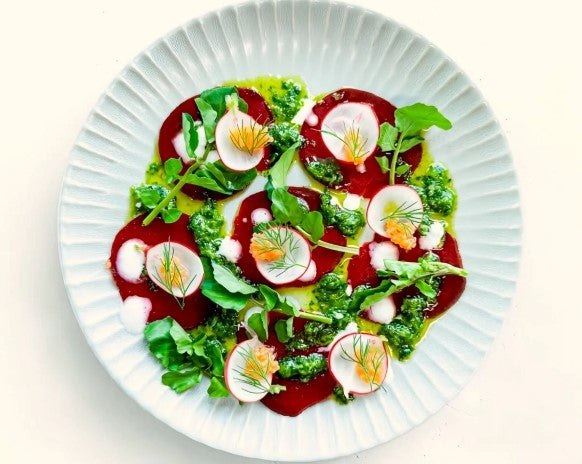
Want a sprinkle of color or a burst of flavor in your daily meals? Microgreens and edible flowers might look tiny, but they’re mighty when it comes to turning everyday dishes into something special.
Pull up a chair (or your yoga mat) because we’re about to dive into a world where greens double as art, flowers taste as good as they look, and your meals become little wellness parties.
In this blog, we’ll explore what each of these beautiful bites actually is, how they differ in flavor, nutrition, and style, and when to let flowers shine, when to lean on microgreens, and how to mix them like a pro.
What Are Edible Flowers?
Imagine opening your fridge and seeing a box of blooms just waiting to land on your plate. That’s the magic of edible flowers. They’re blossoms grown for beauty, taste, and health benefits.
Some favorites you’ll spot in salad bundles:
-
Nasturtiums: Fiery orange petals with a peppery zing
-
Pansies and Violas: Sweet, grassy, almost candy-like
-
Calendula: Golden petals with a hint of saffron tang
They don’t just sit pretty. They whisper, “Slow down, enjoy this moment,” while you fill up your plate. And they make even Tuesday-night yogurt bowls feel like something from a chef’s tasting menu.
What Are Microgreens?
If edible flowers are the artists, microgreens are the personal trainers of your plate; tiny but power-packed.
Harvested just 7-21 days after sprouting, they’re little flavor bombs loaded with antioxidants and vitamins. Some stars of the microgreen world:
-
Radish microgreens: Sharp and spicy, perfect on avocado toast
-
Broccoli microgreens: Grassy, sweet, and loaded with sulforaphane
-
Arugula microgreens: Zesty with a pepper kick
-
Beet microgreens: Earthy with jewel-toned stems
They’re basically wellness in a hand. Adding them to your recipes will make you appear to be familiar with a fancy brunch board.
Edible Flowers vs. Microgreens: Key Differences

Let’s clear up the confusion with a side-by-side peek:
Appearance
-
Edible flowers bring instant elegance and vibrant pops of color to any dish.
-
Microgreens are lush, and their fresh texture exudes a healthy and delicious appeal.
Flavor personality
-
Flowers are gentle, sweet, and sometimes have a citrusy or spicy scent.
-
Microgreens embody bold, earthy, and zesty flavors. They’re the extroverts of the garnish world.
Nutrition
-
Microgreens pack a serious punch: vitamins A, C, and K, along with a plethora of antioxidants.
-
Edible flowers bring phytonutrients and pure visual joy.
Shelf life
-
Microgreens are sturdier and can chill happily in the fridge for days.
-
Flowers are delicate divas that are best enjoyed soon after they are harvested.
Both edible flowers and microgreens have their own place in your diet and fancy recipes. With promised health benefits, a balanced mixture of both is essential.
When to Use Edible Flowers
Edible flowers are for moments when your food deserves its own spotlight. They’re perfect for:
-
Plating dreamy desserts (hello, panna cotta with petals)
-
Floating atop cocktails or mocktails for an instant ‘wow’ from your guests
-
Dressing up charcuterie or brunch boards for your afternoon brunches
-
Adding a cheerful pop to salads or risottos
Don’t pile them on. A single violet on a cheesecake or a nasturtium on a grain bowl is enough to make guests whisper, “How did you even think of that?”
When to Use Microgreens
Microgreens are your everyday wellness buddies, ready to flex their flavor muscles on almost anything:
-
Sandwiches and wraps (goodbye, soggy lettuce)
-
Avocado toast topped with spicy radish greens
-
Omelets or scrambled eggs for an extra layer of freshness
-
Salads and grain bowls for crunch and nutrients
They’re the ultimate ‘no excuses’ veggie. Even on your busiest day, tossing a handful over lunch means you’re winning at health.
Pairing Edible Flowers and Microgreens Together

Mixing edible flowers with microgreens brings balance, combining the nutrition of the greens with the vibrant color pop of the petals.
Try these pairings:
-
A summer salad with arugula microgreens and rainbow pansies
-
A cocktail dressed with violets and mint microgreens
-
A cheese platter scattered with beet greens and calendula petals
It’s like a team workout where everyone shines and your plate looks straight out of a lifestyle magazine.
Check out Planted Detroit’s edible flower mix!
How Planted Detroit Does It Differently
At Planted Detroit, we grow microgreens and edible flowers in a clean, vertical hydroponic farm.
That means:
-
Zero pesticides, zero soil mess
-
Same-day harvest and delivery, so you get petals and greens at their peak
-
Bundles curated for flavor, nutrition, and major wow factor
Every box is an invitation to play in the kitchen, minus the grocery-store hunt. Explore our Salad Bundles and discover how easy it is to keep these favorites on hand.
Edible Flowers, Microgreens, and Your Dish
Edible flowers bring instant elegance to any dish. Microgreens are a powerhouse of flavor and nutrients.
Together, they’re the ultimate glow-up for meals. They’re fun, they’re functional, and they make every plate a little celebration of wellness.
So, let’s experiment. Open the fridge, grab a few stems and petals, and let your inner chef run wild.
Explore Planted Detroit’s bundles and discover how effortless it is to fill your week with color, crunch, and feel-good freshness.
